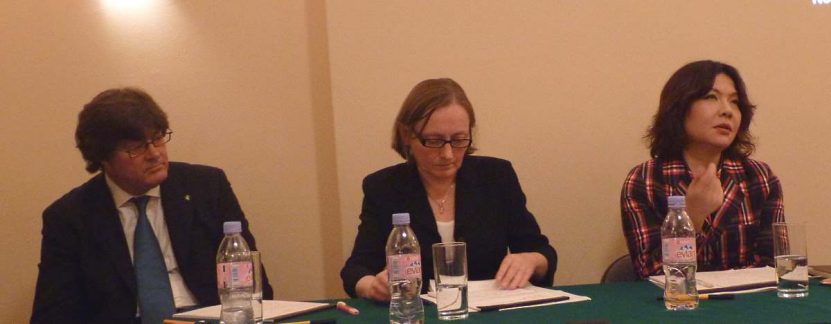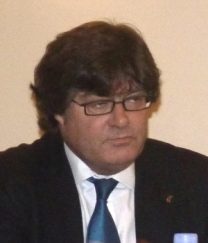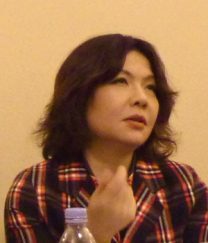 Seminar Series 2011
Seminar Series 2011Wednesday 19 October 2011
6:00pm – 7:45pm
Support for the Arts in the UK and Japan
Drinks reception from 8:45pm
Daiwa Foundation Japanese House
Organised by the Daiwa Anglo-Japanese Foundation
This seventh seminar in the 2011 series, Uncertain Futures: The Individual, Society and the State in the UK and Japan, considered the issues surrounding support for the arts in the UK and Japan. In recent years, arts funding in both the UK and Japan has undergone severe cuts and dramatic changes. Colin Tweedy, Chief Executive of Arts & Business, and Mami Kataoka, Chief Curator of the Mori Art Museum,Tokyo, explored the current landscape and looked to the future in assessing the impact of spending cuts and priorities for supporting the arts in these uncertain times.
Colin Tweedy, the first speaker, began with an overview of Arts & Business explaining that it works closely with arts communities across theUK, sparking partnerships between commerce and culture, connecting companies and individuals to cultural organisations. Arts & Business lists a large number of partners including The Co-operative, Lloyds TSB and Prudential, and over 350 companies as members. It works with 1,200 arts organisations annually through their arts membership, including Cockpit Arts, the British Museum, the ICA and the Royal Opera House to name a few. It also has links to 24 international territories including China, Abu Dhabi, Canada, Russia, Japan and Brazil.
Referring to cuts in cultural funding worldwide, Tweedy pointed out that public funding of cultural activity has been cut by 11% in the USA and 30% in the UK while it has increased by 4% in Norway, as a result of the latter’s oil supplies.
Italy, home to more historic and cultural sites than the rest of Europe, is facing a crisis as a result of its funding cuts as the need to restore ancient sites including Pompei is urgent, and 60 of its 80 opera houses are likely to close in the next couple of years.
The UK cultural sector has seen a dramatic increase in support from earned income and private investment in the last 20 to 30 years. The Royal Opera House, for example, receives less than 40% funding from the state.
The ideal funding model, according to Tweedy, seems to consist of 1/3 from public sources, 1/3 from private sources and 1/3 from earned income. Reaching this formula is a challenge, however.
While public funding in theUK is dramatically decreasing, there has been a huge growth in the number of wealthy business leaders becoming philanthropists. The main sponsors and supporters of culture seem to stem from the finance/banking sector, followed by those in the creative industries including broadcasting companies, and those from the property and construction industry. There has been a dramatic growth in individual philanthropy and support from luxury goods companies such as Louis Vuitton.
Tweedy pondered why people engage and invest in art and suggested they do so not simply because of its entertainment value but because of its ability to inspire people in business.
Companies often use sponsorship as a means of reputation building, but this can result in clashes. LEXUS, the luxury vehicle division of Toyota Motor Corporation, has been keen to support the Wiener Staatsoper, but has found it difficult to engage with it. LEXUS would, ideally, like to have a car on stage as well as outside, demonstrating a clash of cultures.
British Petroleum has had a challenging year, attracting a number of protests from visual artists protesting its backing of the rehang of the Tate Gallery, its sponsorship of the BP Portrait Awards at the National Portrait Gallery and its BP Summer Concerts. The Tate and other organisations which have benefited from BP’s philanthropy have been supportive of BP’s cultural investments.
Travelex’s £10 ticket seasons at the National Theatre have been enormously successful. Lloyd Dorfman, Travelex’s founder and chairman, went on to donate £10 million of his own money to the National Theatre. In recognition, the Cottesloe, the smallest of the theatres, will be renamed the Dorfman in 2014 once the redevelopment project has been completed.
99% of arts organisations are chaired by businessmen and 80% of their boards are made up of businessmen, who can benefit from arts-based training. Deutsche Bank, for example, encourages a number of its bankers to experience circus training.
Referring to the nature of culture, Tweedy said it should be about entertainment, brand, location, content, creativity and authenticity and that the best relationships are those between equals which involve understanding, vision, creativity, measurement, openness and a willingness to share.
Wondering what arts organisations and fundraisers need, Tweedy suggested they need training – people in Britain are usually averse to asking for money, said Tweedy, and hire staff dedicated to this endeavour while in the USA fundraising is done directly by the Chair of an organisation asking another Chair for support. Arts organisations also need an entrepreneurial and networking mindset, board leadership, knowledge and a supportive public funding environment.
More organisations in the UK are now wondering whether they could exist without public money and whether they could raise their own funds, dispensing with the begging bowl.
Across Europe it seems that funding will be reduced for a generation, commented Tweedy. Funding levels won’t return to previous levels for 5 or 10 or 15 years.
Tweedy ended by recognising the enormity of the challenges which lie ahead. In theUK, for instance, 75% of all funding from the private sector goes to London and 75% of this goes to 25 institutions.
The second speaker, Mami Kataoka, gave a personal observation of what is happening in Japan.
She began by saying that though the new government of 2009 (led by the Democratic Party of Japan) had to implement spending cuts, the Agency for Cultural Affairs’s arts budget has increased. The Japan Foundation, however, under the jurisdiction of the Japanese Ministry of Foreign Affairs (MOFA), has been affected and had its budget cut.
44% of The Agency for Cultural Affairs’s funds go towards the preservation of historical artifacts such as shrines, temples and religious artifacts. 40% is spent on the promotion of Japanese culture and on media art such as manga, animation, entertainment and games. There is a huge focus on media arts which has led to complaints leveled at MOFA and the Ministry of Industry and Commerce for disregarding visual and historical art.
Kataoka then looked into private support for the arts, focusing on certain individuals in Japan who had built up their own collections.
The Matsukata Collection, which formed the core of the National Museum of Western Art, came about when Kojiro Matsukata, who made a fortune out of shipbuilding as president of Kawasaki Shipbuilding Company during the First World War, began collecting sculpture, paintings, tapestry and 8,000 woodblock prints from Parisian galleries. His collection was requisitioned by the French government after the Second World War but most was returned and transported to Japan with the signing of the San Francisco Treaty of 1951.
Another collector, Shojiro Ishibashi, founder of Bridgestone Corporation, began collecting art during the Second World War and set up the Bridgestone Museum of Art in 1952.
Kaichiro Nezu, another industrialist and president of Tobu Railway, opened the Nezu Museum in 1941, which holds an important collection of pre-modern Japanese art and tea sets. The museum was renovated by Kengo Kuma in 2009.
Hiroshi Teshigawara, son of the founder of the Sogetsu School of ikebana, opened the Sogetsu Art Center in 1958 which, until its closure in 1971, was eclectic and staged films, dance and exhibitions and attracted well-known artists such as David Cage, Merce Cunningham and Yoko Ono during the 1960s.
Seiji Tsutsumi’s Sezon Museum of Modern Art (1975-1999) was extremely important during its heyday in the 1980s and also attracted high-profile artists such as Jasper Johns and John Cage. It closed down in 1999, prompting the closure of all other department store top-floor gallery spaces.
The Hara Museum of Contemporary Art, housed in an art deco building, and dedicated to contemporary art, was opened by Toshio Hara in 1979. In the 1980s and 1990s it assiduously promoted Japanese artists and held annual exhibitions similar to the UK’s Turner Prize. It continues to stage important exhibitions.
Minoru Mori, the founder of the Mori Art Museum which opened in 2003, is a property developer whose interest is not primarily art but town planning and revitalising urban areas. The success of his 1986 Ark Hills which comprises a concert hall, exhibition spaces and eating areas, led to it becoming a nationwide model copied by municipalities and encouraged Mori’s vision and creation of the Roppongi Hills area.
It took 16 to 17 areas for the Mori Art Museum to finally open. As well as exhibitions in the gallery space on the top floor of the Mori Building, a number of events and festivals are held on the ground level. Admission to the gallery is included in the ticket for the viewing deck, an effective way of attracting hundreds of thousands of visitors to see the cutting-edge art displayed in the gallery.
The gallery attracted a staggering half a million visitors in its first year and over 700,000 in its second year. Given its success and involvement with the community, the Tokyo Metropolitan Government and the Agency for Cultural Affairs have chipped in, supporting its collective activities. The annual Roppongi Art Night, derived from the Paris White Night, offers a series of cultural events from sunset to sunrise.
Kataoka’s last example – 3331 Arts Chiyoda was launched by the artist Masato Nakamura in 2010 in a former junior high school which is now an active artistic hub. Chiyoda Ward in Tokyo allowed Nakamura to take over the school free of charge. He now rents rooms to artists and galleries, accounting for 50% of his business income. The space has been an enormous success and his artist in residency programme has successfully taken off. Hailing fromAkita, Nakamura, is doing his best to try and revitalise the northeast of Japan which was affected by the earthquake and tsunami of March 2011. He is an example of how small power and budget can come together and create a larger project and has inspired other young artists to work as a collective.
The Japanese museum boom of the 1980s and 1990s has resulted in a museum in every prefecture as well as in 30% of all cities. With the demise of the bubble economy, however, museums and galleries have been left standing but without a budget for programming or building a collection.
Kataoka said that it would take another few decades for the Japanese government to deal with these current economic uncertainties and that Japan evinces a different model from that of the UK. Ironically, Japanese artists never expected to be supported by the government but now are in a position whereby they are benefiting from government support.
The collectors mentioned in her talk, she concluded, are or have been interested in engagement with art or in revitalising areas rather than in philanthropic work itself. Art, it has been shown, can work as a force to rebuild local towns, deal with ageing issues and as a provider of vital energy .
The questions and answers following the talks were varied and lively and covered themes such as whether the decline of public funding would result in more or less dissident or political art, whether public and private funding could overlap through tax incentive systems, what the biggest incentive for private funding other than tax deduction might be, whether there is something in the Japanese psyche that means that Japanese individuals create their own museums and collections rather than engage in philanthropic giving, the fact that match funding can prove a dramatic way of incentivising philanthropy, the irony that many Japanese companies invest in arts abroad while neglecting cultural organisations at home, the fact that more organisations are focusing on digital fundraising and benefiting from a new e-audience and that a balance of 30/30/30 between private, public and earned income seems the ideal model as it avoids excessive dependence on any one source.
The chair, Jenny White, concluded on a positive note by acknowledging that the speakers had pointed ways through this present period of uncertainty and suggesting that, as demonstrated by Minoru Mori who courted ‘uncertainty’ in the seemingly risky positioning of his gallery, it (uncertainty) can be a positive spur, working as a dynamic medium or spark catalyst.
About the contributors

Colin Tweedy
Colin Tweedy OBE is the Chief Executive of Arts & Business. He is also Chairman of CEREC (Comité Européen pour le Rapprochement de l’Economie et de la Culture). He is a Trustee of the Headlong Theatre, the Mariinsky Theatre Trust, the Serpentine Gallery and The Prince’s Foundation for Children & the Arts. Colin Tweedy is also a director of The Ideas Foundation, a Council member of the National Musicians Symphony Orchestra and a Governor of the University for the Creative Arts. He is a Fellow of the Royal Society of Arts (FRSA). In 2000 he received an OBE for services to business partnerships with the arts in The Queen’s Birthday Honours.

Mami Kataoka
Mami Kataoka has been the Chief Curator at the Mori Art Museum (MAM) in Tokyo since 2003. She is currently overseeing many international projects, including the 9th Gwangju Biennale 2012 in South Korea as the Joint Artistic Director, and [i]Phantoms of Asia[/i] at the Asian Art Museum in San Francisco as guest curator. She was the International Curator at the Hayward Gallery in London between 2007 and 2009, curated [i]Laughing in the Foreign Language[/i] (2008) and co-curated [i]Walking in My Mind[/i] (2009). Kataoka frequently writes and gives lectures on contemporary art in Asia.

Jenny White (Chair)
Jenny White has 25 years’ experience of producing arts projects in UK, Latin America, East Asia and Japan. After working as manager of Scotland’s Communicado Theatre, she first encountered the British Council, and worked with them, initially in Japan for ten years, introducing contemporary British artists and programming two UK-Japan festivals UK90 and UK98, and then in Thailand and in London, as Head of Arts Development. From 2006-2009, she was Director of the British Council in Cuba, hosting the visit of the Royal Ballet and producing UK’s contribution to the Latin American Film Festival and the Habana Biennial of Art. She is currently on assignment to manage the Environmental impact of British Council’s global cultural relations work. With a lifelong interest in Japan and the intersection between Japanese and British cultures, Jenny will draw on her experience to contribute to this topical debate for both the UK and Japan.